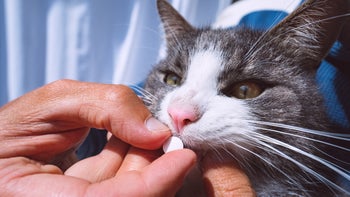
Why Does Your Cat Bite You? 9 Common Reasons and What You Can Do About It
Key takeaways:
Cats bite for a variety of reasons, such as being in pain, defending themselves, or asking you to back off.
Giving your cat a toy they can pounce on and nibble may help manage their biting.
Your veterinarian may recommend medication for your cat if biting becomes a behavioral issue.
Table of contents

A cat bite may not seem like a big deal. After all, it’s dog bites that often make headlines and require medical attention. But cat bites can be painful, cause infections, and become a behavioral problem.
That’s why it’s important to understand why cats bite and what you can do to curb their behavior.
Why do cats bite?
There are many reasons a cat might bite. They may nip because they want to be left alone or because they feel overwhelmed by your attention.
Search and compare options
Here are nine of the most common reasons cats bite.
1. They’re overstimulated
Petting a cat along the wrong part of their body and for too long can overstimulate them.
“Cats like to be pet from the neck up,” Ingrid Johnson, a certified cat behavior consultant and owner of Fundamentally Feline, told GoodRx. “Too many swipes down the spine could get them riled up and possibly cause them to bite.”
2. They think it’s part of playtime
Some cats get a bit aggressive and bite when they’re playing. Researchers say this often happens when a cat is weaned early and then hand-raised by people. They didn’t learn at a young age from other cats that biting is not socially acceptable.
3. They’re showing love and affection
According to Johnson, some cats may open their mouths over your hand or arm. They then release and lick. “That’s just a sign of affection,” she said.
4. They’re feeling defensive
A fearful cat may act aggressively to protect themselves from a perceived threat. Their behavior may include hissing, spitting, arching their back, and biting.
Wondering what your cat’s thinking? We were wondering, too, so we did the research on what’s going on in your cat’s mind. See what you think!
The cat’s meow: Why do cats meow? As with biting, there can be a number of reasons for meowing. Here are the most common causes behind a meowing cat.
Cat scratch disease: Worried about getting sick from a cat scratch? Get the facts about cat scratch disease and how you can protect yourself.
5. They have medical issues
Itching or pain from a medical condition can cause a cat to bite. A skin abscess, tooth infection, or joint aches from arthritis might explain your cat’s behavior.
6. They’re trying to tell you something
Cats often give other signals before they bite. “They don’t resort to biting as a first line of defense,” Johnson said. “Their tail will start to flick. They might get up and walk away from you. Their ears might go down and back. The cat is essentially screaming at you to please stop.” If you miss their cues, they may take a bite out of you.
7. They want to be left alone
Sometimes a cat just wants to be left alone. They bite to communicate, “I need space.”
8. They don’t want to be touched
Some cats have a condition called feline hyperesthesia syndrome (FHS). These cats have a low tolerance for physical touch because their skin is hypersensitive. They sink their teeth into you to let you know there’s something wrong.
9. They want attention
This is probably the least likely scenario, Johnson said. “Cats can have attention-seeking behavior. But they’re much more likely to bite from too much attention,” she said.
How to stop your cat from biting you
There are a number of things you can do to stop your cat from biting you, including:
Dangle toys in front of your cat to simulate hunting. They should be able to chase, pounce, and bite their toys instead of biting you.
“Reward behaviors you like, and ignore behaviors you don’t,” Johnson said.
Use clicker training to reinforce appropriate behaviors.
Avoid punishing your cat. This can cause fear and anxiety in your animal without resolving the problem.
Avoid situations that trigger biting.
Ask your veterinarian about medication if your cat’s biting is out of control.
Johnson asks her clients whose cats are biting to go 3 weeks without touching their cat and engage in other ways that don’t involve touching. They should then reintroduce touch from the neck up, making it brief and leaving their cat wanting more attention.
“Playing hard to get is much more inviting to a cat than being overbearing,” Johnson said.
Frequently asked questions
Licking followed by biting is normal grooming behavior for a cat. “Cats lick and bite when they groom each other, so they do that to us, too,” Johnson said.
You can definitely tell the difference between a love bite and an aggressive bite. In a love bite, your cat will put their mouth on your hand or arm and hold. They will not puncture your skin. An aggressive bite is often preceded by hissing and snarling. Your cat will bite hard and inflict pain.
Do not discipline your cat for biting. Any form of punishment can create fear in your cat and worsen unwanted behavior. Instead, ignore them or redirect their attention.
If a cat bites you and draws blood, treat the injury like you would any puncture to the skin. Clean the area with an antiseptic soap and apply a bandage. If the wound is severe or you don’t know the cat’s medical history, visit an urgent care facility or emergency room.
The bottom line
Cats bite people for a variety of reasons. They might bite because they feel overwhelmed by your attention or have a medical condition that causes pain. Other reasons for cat bites include feeling threatened, wanting to be left alone, and feeling prickly due to a hypersensitivity to touch.
You can try to train your cat to stop biting by avoiding triggers, petting them only from the neck up, and giving them toys to pounce on and bite. You may also have to pet your cat less than you’d like. A veterinarian can prescribe medication to help manage the behavior.
If you get bitten by a cat and the injury punctures your skin, clean the area with antiseptic soap. Consider going to an urgent care facility or seeing your doctor if the bite is severe or you don’t know the cat’s medical history. Cat bites can cause infections in people.
Why trust our experts?



References
Cat School Clicker Training. (2020). How to start clicker training your cat. YouTube.
Cornell Feline Health Center. (2016). Feline behavior problems: Aggression. Cornell University College of Veterinary Medicine.
Cornell Feline Health Center. (2021). Hyperesthesia syndrome. Cornell University College of Veterinary Medicine.
Fundamentally Feline. (n.d.). About cat behaviorist Ingrid Johnson.
Haddon, C. (2022). Behavioural considerations for biting cats. Improve Veterinary Practice.
Landsberg, G. M., et al. (2014). Behavioral problems of cats. Merck Veterinary Manual.
Office of the Vice President for Research. (n.d.). Bites and scratches. UConn Health.
Overall, K. L. (2006). Cats who bite people who pet them. World Small Animal Veterinary Association World Congress Proceedings, 2006.
Texas A&M University Veterinary Medicine & Biomedical Sciences. (2017). Disciplining cats and kittens.

























